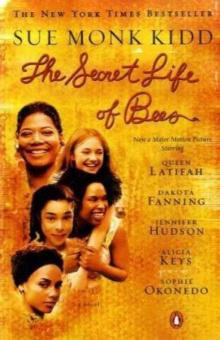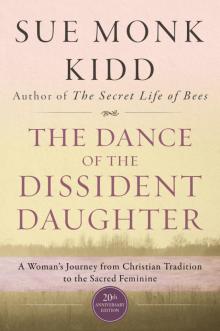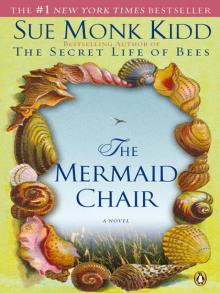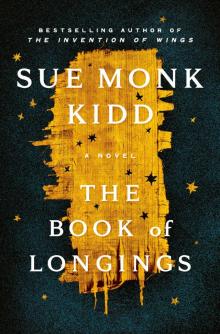- Home
- Sue Monk Kidd
The Dance of the Dissident Daughter Page 8
The Dance of the Dissident Daughter Read online
Page 8
While I didn’t go quite that far, I realized that I did often look to Sandy for identity, approval, and validation. I depended on this the way he depended on my being in the self-sacrificing role.
Another film comes to mind, this one portraying a forty-two-year-old London housewife who is living the Secondary Partner to such a degree it has taken on the overtones of parody. Shirley Valentine opens with the soundtrack singing, “I’d like the chance to be the girl who used to be me.” The recurring question in the film is: What happened to Shirley Valentine? Shirley Valentine was her maiden name, the name she had when she lived from her own center, when she was daring and stuffed full of passion for life. Her quest is to recover her essential self, her Shirley Valentine self.
With her children grown and her marriage settled into deep, deadening ruts, her existence is like modeling clay, stretching and molding itself to her husband’s life. He wants chips and eggs on Monday, steak on Thursday. He wants his wife always nearby to meet his needs but not too intrusive; she should be just there, available and useful like an umbrella in its stand.
When Shirley gets a chance to go to Greece with a friend, she seizes the trip as part of her quest, though her husband forbids her to leave. One night sitting beside the Greek shore, Shirley thinks to herself, “I’ve allowed myself to lead this little life when inside me there is so much more. . . . That’s where Shirley Valentine disappeared to. She got lost in all this unused life.”
She meets Costas, a fun-loving Greek restaurant owner who takes her out on a boat. She tells him that when she was a girl—when she was Shirley Valentine—she used to be daring. She used to jump off the roof. Encouraged by Costas, she begins to recover this lost self as the two of them jump off the boat into water that, he tells her, is as deep as forever.
When the vacation is over, Shirley stays on, working in Costas’s restaurant, waking up with the sea outside her window, soaking up life in the tiny, sun-drenched village, learning to laugh and dare again, and gradually reclaiming herself. She blossoms, ignoring all her husband’s angry orders to come home.
My favorite scene is when her husband arrives in Greece in order to try to reconcile their lives. She waits for him at a table by the sea, watching him trudge up the hill. He passes her, then turns back. “I didn’t recognize you,” he said.
“I know,” she tells him. “I used to be the mother. I used to be the wife. But now I’m Shirley Valentine.”
That morning as I lay in bed watching my husband sleep, I yearned to transform the model of our marriage, to find my unused life, which is the work a Secondary Partner will need to do. I needed to find the woman I’d left behind and to challenge the conventional orbits of my relationship. But if I did all that, what would happen to my marriage? Could it sustain that sort of transformation? I had my qualms about it.
The Many-Breasted Mother
Another blueprint given to women, the Many-Breasted Mother, is one of the more revered. The image came to me as I watched a peculiar sight on the television news, an overwhelmed mother dog nursing a small litter of newborn kittens along with her own brood of pups. The kittens had been brought to her when their mother died. The mother dog lay sprawled on her side overrun with mouths, some that naturally belonged to her and some that didn’t. “Poor thing, all she seems to do all day long is nurse something,” said the owner.
Women have been encouraged to embrace the all-nurturing (many-breasted) role of womanhood as the jewel in the female crown. And while mothering can be a deeply beautiful role, it can also become distorted by self-negation. The Many-Breasted Mother ends up caring for an array of children, including projects, needs, groups, and persons, that may not even belong at her breast.
I remembered a verse I’d scrawled once when my children were small and I was feeling engulfed by the role of mother:
Priestess of dutiful sacrament.
You knead your soul into bread.
You serve it on a silver tray,
Bright morsels for your family to eat.
Aren’t you hungry too?
Even as my children grew and became teens, many times my role as nurturer allowed the very essence of my life to be overrun and eaten away. Sadly, I know women who keep doing this even after their children have grown and left home.
When my Many-Breasted Mother really kicked in, I even found myself taking care of my husband. I would be sure he ate well, encourage him to exercise, make sure he had a shirt ironed for his meeting, table my issues to soothe his bad mood.
Women have been trained to be deeply relational creatures with “permeable boundaries,” which make us vulnerable to the needs of others.36 This permeability, this compelling need to connect, is one of our greatest gifts, but without balance it can mean living out the role of the servant who nurtures at the cost of herself.
Referring to this feminine script in her essay “Professions for Women,” Virginia Woolf describes the syndrome and offers a drastic remedy:
She was intensely sympathetic. She was immensely charming. She was utterly unselfish. She excelled in the difficult arts of family life. She sacrificed herself daily. If there was chicken, she took the leg; if there was a draft she sat in it—in short she was so constituted that she never had a mind or wish of her own, but preferred to sympathize always with the minds and wishes of others. . . . I did my best to kill her. My excuse, if I were to be had up in a court of law, would be that I acted in self-defense. Had I not killed her, she would have killed me.37
At the very least we need to disempower this part of ourselves, to relieve ourselves of the internal drive to forfeit our souls as food for others.
The Favored Daughter
One of the more uncomfortable discoveries I made about myself during this time was a need to prove myself to the father-world—my own father, the cultural father, the church father. The powerful male presence. I began to recognize how important it was to me that he be aware of my accomplishments. The need surfaced from a deep place in my feminine wound.
I’d grown up the firstborn in a field of bright, athletic brothers, unconsciously trying to convince everyone that being a girl was every bit as worthy. Certainly no one ever said to me that girlhood was less valuable. I simply picked it up by virtue of being female on the planet. And I set out to prove it wrong. I tried through a blaze of achievement: A’s on the report card, school honors, swimming trophies, cheerleading trophies, church awards. I did it through compliance. I did it by being everything I imagined a good girl should be.
It had been a core pattern of my life, this attempt to be a Favored Daughter.
Favored Daughters are women who, carrying the wound of feminine inferiority, try to make up for it by seeking the blessing of the cultural father. Through accomplishments and perfectionism we hope to atone for the “original sin” of being born female. We are hoping that Father God will finally see our worth.
Even as an adult woman, I’d set up perfectionist standards, which kept me striving. I pursued a thin body, happy children, an impressive speech, and a perfectly written article with determination to succeed, but also with an internal voice that led me to feel whatever I did wasn’t quite enough. I worried about not measuring up.
Herein lies the torment of it: Favored Daughters strive for their worth, piling up external validations, but inside they are most often plagued by self-doubt, wondering if their work or their efforts are good enough.
I met a Favored Daughter at a conference in Atlanta. A successful businesswoman, she told me her story one afternoon over coffee. “All my life I’ve been internally driven to succeed at things,” she said, “even things that don’t matter all that much. I had to be a star at everything. When I finally asked myself why, what came to me was the time my father took me to a Braves baseball game.
“I got the chance only because my brother was sick that day. I was a daydreamy girl who didn’t care much for baseball, but I tried to like it to make my father happy. He loved the game almost irrationally. And he love
d my brother the same way, I think, because he was a boy. My father loved me, too, but he didn’t value me the way he did my brother. I always had the feeling that if I’d been a boy, he would have loved me in that same irrational way.”
Suddenly her eyes grew teary. She said, “That day at the ballpark I was looking up at the sky counting the clouds, which was this thing I did. And here comes a foul ball flying into the stands, landing right at my feet.
“I was so lost in the clouds I didn’t hear my father shouting at me to pick up the ball. By the time I realized what was happening, someone else had grabbed it. What I remember most is my father’s reaction. He said, ‘Geez, you girls. You think your brother would have lost the ball like that?’
“I’ve spent my whole life since trying hard not to drop the ball, trying to make it up to my father for being nothing but a girl, hoping I could finally get him to prize me like he did my brother. The crazy thing is, I have this nineteen-page résumé, but still there’s a voice inside telling me I’m going to mess up.”
I didn’t know what to say to her except that I understood, that undoubtedly we were looking for validation in the wrong place. That we needed to quit trying and go recover the primacy of our feminine souls. Then maybe our sense of worth and confidence as women in the world would flow to us fully and naturally.
I’ve met so many of these women, heard so many stories like this. They are all different, and yet they are all the same. In every one the woman is sitting in the bleacher (or the pew, the school desk, wherever) just being her girl-self when the moment of truth descends kerplunk! at her feet—that in this family, this church, this culture, female is the less-prized gender. She starts to feel that her gender has somehow “dropped the ball.” And without even being aware of what she’s doing, she may try to make up for it by going through life trying to win love, validation, and esteem from the father-world.
The Silent Woman
Throughout all this unnaming I was doing, I kept thinking back to the sketches I’d drawn of the mouthless woman. I knew they were attempts to capture the pattern of the Silent Woman in myself.
I began to reflect on the ways I’d withheld my opinions, muzzled disconcerting truths, refrained from expressing my true feelings, squelched my riskier ideas, or thwarted my creativity. When I did that, I was living out the script of the Silent Woman. Being a Silent Woman is not about being quiet and reticent, it’s about stifling our truth. Our real truth.
I wondered, Had silence encroached as I internalized the message of inferiority? Had I learned that silence was a safe place?
Some of the scripting concerning silence has come from the church, from Bible verses like this one: “Let a woman learn in silence, with all submissiveness” (1 Timothy 2:11, RSV). We may not claim this verse as a guiding principle, but it’s there inside us nonetheless.
Overall, women’s voices have not been encouraged unless they spoke as mouthpieces for the party line. Quiet ladies who held their tongues were loved and lauded. Uppity, pioneering women who spoke their minds and said bold things were attacked and sanctioned. “And that plays into our greatest fear, which is going against convention and having love and approval taken away,” says writer Erica Jong.38
Very often silence becomes the female drug of choice.
I grew aware that while I spoke a lot, much of the time my deepest words, my outrage, the voice of my feminine soul, were silent. For the first time I began to feel the confinement of my creative voice. There were things I wanted to say, needed to say, yet they didn’t lie within the boundaries of “Christian writing.” In Gail Godwin’s novel, A Southern Family, one of her characters, a writer, wonders if she writes “to satisfy the tastes of the culture that shaped me.”39 Now I wondered, Had I? Where had I hedged, pulled back, or diluted my truth?
As I reflected on these questions, I stumbled by chance upon the Greek myth of Philomela. It is the story behind the Silent Woman, and it goes like this: While traveling to see her sister, Philomela was raped by her brother-in-law, Tereus. Outraged, she threatened to tell her sister and the world what he’d done to her. He responded by cutting out her tongue and banishing her to a guarded tower where she was forced to live in silence.
Eventually, though, she seemed to know that if she continued to be silent she would die. So Philomela began to weave a series of tapestries that became her voice and told her story. She then enlisted an old woman to take them to her sister, who came and liberated her.
The myth is about the loss of women’s voices. It suggests that the source of female silence is the rape of the feminine—the devaluation and violation of femaleness. It suggests that when women protest this violation, their voices are frequently squelched through ridicule, sanction, and fear of reprisal. In the public arena, at church, work, and home, women’s tongues are often silenced when we dare to speak our anger, truths, and visions.
In 1993 the Councils of Churches in the Twin Cities and Minnesota sponsored a Re-imagining Conference. I didn’t attend but I read about the multiplicity of women’s voices that were raised there expressing women’s truths, imagining bold feminine images of God, and presenting new challenges to the church. I also read dozens of editorials and letters to denominational papers by church traditionalists who reacted to these voices by castigating, repudiating, and calling for denunciation, full-scale church inquiries, and resignations.
Poet Muriel Rukeyser writes, “What would happen if one woman told the truth about her life? / The world would split open.”40
Today the world is starting to split open with women’s truths. The fear of voicing ourselves still runs deep, but women are still weaving their truths into a tapestry of stories and sending them out into the world.
In the end, speaking out would become the cure for my feminine silence. It would not necessarily banish my fear and reluctance, but I would learn to voice my soul in spite of it. To speak as if my life depended on it.
FORMING A FEMINIST CRITIQUE
By now more than a year had passed since my dream of giving birth to myself. I went about my routine—writing, being mother to my teenaged children, seeing friends, jogging, reading a lot, painting a little, serving on an occasional committee, going methodically to church, and, through it all, keeping my awakening mostly secret.
Part of it was because I was afraid of the response I might get. But secluding my experience during that early period was both cowardly and wise. Some things are too fragile, too vulnerable to bring into the public eye. Tender things with tiny roots tend to wither in the glare of public scrutiny. By holding my awakening within, I contained the energy of it, and it fed me the way blood feeds muscle. It fed me a certain propelling energy, and I kept moving forward.
I had finally told myself the truth about the presence of the feminine wound and the way I’d adapted to it. Now I began to tell myself the truth about how this wound came to be inflicted. I began to form what I called my feminist critique.
Forming a critique is essential to the birth and development of a spiritual feminist consciousness. Until a woman is willing to set aside her unquestioned loyalty and look critically at the tradition and convention of her faith, her awakening will never fully emerge. The extent of her healing, autonomy, and power is related to the depth of the critique she is able to integrate into her life.
As I formed my critique, I came face to face with a system of social governance, a vast complex of patterns and attitudes within culture, religion, and family. The name of the system is patriarchy. It’s important to emphasize that patriarchy is neither men nor the masculine principle; it is rather a system in which that principle has become distorted.
The word patriarchy comes from the Greek word pater, which means father, and archein, which means rule. It has come to mean a way of social organization marked by the authority or supremacy of men and fathers. Western civilization has been organized this way since its prehistory, though patriarchy is now showing signs of real demise.
Learning to see pat
riarchy, not as I was conditioned to see it, but as it actually is—a wounder of women and feminine life—was not easy. One reason is that since patriarchy is so pervasive and familiar, it becomes invisible.
Psychotherapist Anne Wilson Schaef compares living in patriarchy to living in polluted air. “When you are in the middle of pollution, you are usually unaware of it. You eat in it, sleep in it, work in it, and sooner or later start believing that is just the way the air is,” she writes.41
In a similar way we’ve accepted the widespread attitudes and effects of patriarchy as givens. They are so much a part of the world, we start to think that’s just the way reality is.
In the play The Search for Signs of Intelligent Life in the Universe, a deceptively wise bag lady named Trudy mutters, “What is reality anyway? Nothin’ but a collective hunch.”42
Far from being the sole reality, patriarchy is actually nothing but a collective hunch. For women, making this fine distinction—that it is only one way of viewing reality and not reality itself—is crucial in helping us see patriarchy clearly.
The Hierarchy
As I began to observe the patriarchal world around me with more clarity, one of the first things I noticed was a principle that seemed to lie at the very heart of it: Life is a hierarchy with men and so-called masculine values at the top.
The hierarchy goes like this: at the top God, then men, then women, children, animals, plants, and minerals. (Of course there are also hierarchies within hierarchies as we consider issues of race, culture, and economic status.) Embedded in the human psyche, this hierarchal view has been passed on as the natural and “divinely created” order of life.

 The Secret Life of Bees
The Secret Life of Bees The Invention of Wings
The Invention of Wings Traveling With Pomegranates
Traveling With Pomegranates The Dance of the Dissident Daughter
The Dance of the Dissident Daughter The Mermaid Chair
The Mermaid Chair The Book of Longings
The Book of Longings The Invention of Wings: A Novel
The Invention of Wings: A Novel The Invention of Wings: With Notes
The Invention of Wings: With Notes